| Casino Royale Soundtrack LP Record Stereo Herb Alpert |
|
-
The Facts
- Rated: PG
- Official Year: 1967
- Number in Series: Unofficial
-
PDF
File:
- Running Time: 131 minutes
- Budget: $12 million
- UK Premiere: April 13, 1967
- US Premiere: April 19, 1967
|
Cast
- James Bond: David Niven
- Moneypenny: Barbara Bouchet
- M: John Hston
- Q: Geoffrey Bayldon
- Bond Girl (Vesper Lynd): Ursula Andress
- Villain (LeChiffre): Orson Welles
- Henchman (Smernov): Kurt Kasznar
|
Crew
- Writing Credits: Ian Fleming
- Producer: Charles K. Feldman
- Producer: Jerry Bresler
- Director: Val Guest
- Composer: Burt Bacharach
- Title Song: Herb Albert & the Tijuana Brass
- Production Design: Michael Stringer
-
Full
Cast & Crew: IMD
|

Peter Sellers was well known for portraying
various parts. On the left he mimics a Cary Grant-like pose as James Bond.
On the right, he dresses up as artist Toulouse-Lautrec.
McGrath was a Scottish television director and
worked with Sellers on shows such as Tempo. Sellers convinced Feldman
that McGrath was the right choice to direct the film. According to Sellers’
biographer, Roger Lewis, McGrath was chosen because Sellers wanted to
‘recreate the happy anarchy of his early days on TV’.
In the summer of 1965, Feldman had approached
David Niven to play the part of Sir James Bond. After reading the script at
Feldman’s home and than witnessing it being locked in a private safe, Niven
agreed to play the part that would have him presiding over the Secret Service
while observing a multitude of James Bonds fighting against Smersh.
The cast grew on a daily basis and began to
resemble a British version of the film comedy, It's A Mad, Mad, Mad, Mad,
World. Ursula Andress is added to the film in the role of Vesper Lynd
as well as Orson Welles in the part of Le Chiffre. Followed by Daliah Lavi,
William Holden, Charles Boyer, Kurt Kaznar, Jacqueline Bisset, George Raft,
Jean-Paul Belmondo, Joanna Pettet, Barbara Bouchet, Angela Scholar, Anna Quayle,
Ronnie Corbett, Bernard Cribbins, Tracy Reed, Geoffrey Bayldon, John Wells,
Duncan Macrae, Graham Stark, Burt Kwouk, Vladek Sheybal, and Peter O’ Toole. On January 11, 1966, Casino Royale began filming at
Shepperton Studios, United Kingdom.
From Here On, All Hell Broke Loose
"There’s been nothing like this since
Michael Todd’s ‘Around the World in 80 Days’," said one man on
the set. A comment that referred to the large scale production, with an all star
cast including David Niven from ten years before. The only difference between
the two films would be the adaptations from their original sources. Jules
Verne’s novel was faithfully recreated but Casino Royale most likely
had the late Ian Fleming rolling in his grave. Feldman was aiming to make the
biggest, star-studded, comedy in history and he began it by flooding the screen
with the world’s most beautiful women.
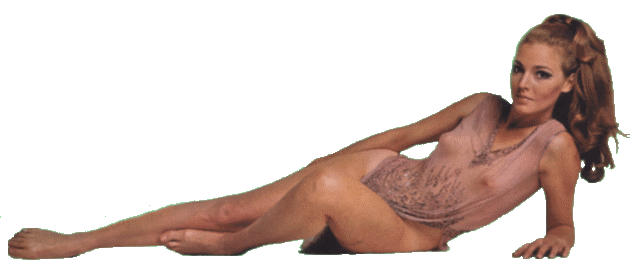
Joanna Pettet ended up portraying the sexy
daughter, Mata Bond.
"No background dogs in my
picture," barked an order from Feldman. "Get only real beauties."
And with that literally hundreds of Britain’s finest auditioned to play Fang
Girls, Guard Girls, Casino Girls, Karate Girls, and 12 daughters of ‘M’, all
between the ages of 16 and 18.
There was a filing system to help avert numbness:
Type ‘A’: must have first, personality; second figure; third looks. Type
‘B’: first, looks; second, figure; third, no personality. Type ‘C’:
those who just get by on all three. Whatever the system, Casino Royale
certainly has the largest of any cast of beautiful women.
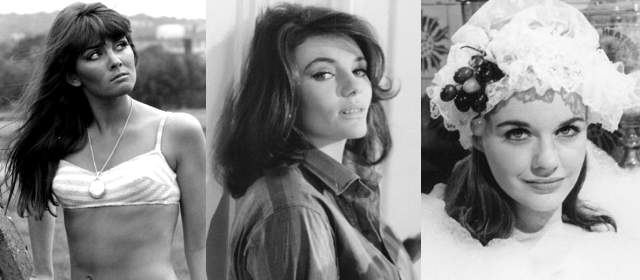
Three famous Bond girls. Caroline (The
Spy Who Love Me) Munro, Jacqueline (The Deep)
Bisset, and Angela (On Her Majesty's Secret Service) Scoular.
Perhaps the biggest problem behind the scenes was
Peter Sellers. At the time he was married to Britt Ekland, who would later play
Mary Goodnight in the 1974 Bond film The Man with the Golden Gun.
Sellers marriage was on the rocks and he was chasing after her every weekend in
order to save it. He refused to listen to any production assistant who was
in-charge of getting him to the set and reportedly was late to the set daily or
would not arrive at all.
Sellers ego would be his Achilles heel, he would
really be annoyed if people did not pay attention to his needs as an actor. On
one occasion, Leo Jaffe, the executive vice president of Columbia, visited the
set and made a mistake by thinking Woody Allen was Peter Sellers. "When you
put glasses on them," said Feldman, "they do sort of look alike."
Sellers was not amused over this mistake.
During the baccarat scene long time Seller’s
friend, Princess Margaret, visited the set and rushed to meet Orson Welles.
Reportedly ignoring Sellers. Welles, who played the part of Le Chiffre, gave a
sarcastic comment to Sellers concerning his tardiness and causing the film to go
over budget. This made Sellers so irate that he insisted that his scenes with
Welles be done with a stand-in. Because of this on-set rivalry only one shot is
shown during the entire scene with both Sellers and Welles in the same frame.

Orson Welles as Citizen Le Chiffre.
Sellers eventually lashed out against his long
time friend Joseph McGrath and literally disappeared for weeks forcing the
production to come to a halt. According to Val Guest, Feldman was furious and
decided to terminate Sellers contract, firing him from the picture. Then
he put plan two into operation and began rewrites and building of newer sets at
Pinewood Studios and Elstree Studios. Because of Sellers tantrums, Feldman
radically altered Royale’s storyline. This left McGrath irritable and forced
Feldman to hire four more directors, Val Guest, Ken (Chitty Chitty, Bang, Bang)
Hughes, Robert Parrish, and John (The Maltese Falcon) Huston. Richard
Lester was also asked to join but turn down the offer because he was friends
with both Sellers and McGrath. The film would now be directed in four parts
"Our concept for this film includes not only multiple stars, but also
multiple directors," said Feldman in the March 2, 1966 edition of Variety.
Feldman also hired a small army of writers to
‘juice up’ the script. Famous writers and directors such as Billy Wilder,
Joseph Heller, Terry Southern, and Michael Sayers added their inputs. The
situation was too much for McGrath. He left the unfinished film after he
completed his contractual agreement.
Sellers eventually came back to film other scenes,
but kept calling his friend McGrath and begging him to return. "Please come
back! Charlie will give you a Rolls Royce if you come back. He gave me one!"
After a while, Feldman did call McGrath and offered him a Rolls Royce if he
would return. McGrath did not. Two years later, co-producer Jerry Bresler drove
up to McGrath in a white Rolls Royce and said, "I’m driving the car
Charlie Feldman was going to give to you if you came back to the movie."
Biblical Proportions
John Huston was fresh off of finishing the epic
film The Bible before he was invited to direct a sequence of Royale.
He was asked how did he get from King James to Ian Fleming?
"Well, it was broached to me as a lark,
which it was. I said, I’ll do it if you let me write my segment of the picture
and shoot it my way." (New York Times interview June 26, 1966)
Huston went on to say that Robert Morley was
first asked to play the part of ‘M’ but was too busy. Feldman then offered
Huston a painting if he would play the part, so he did, bald and with a Guards
mustache. However, he preferred to be paid not by a painting but by a Greek
bronze head, which he recently fallen for. Ironically, it turned out to be
worthless.
Huston directed his scenes with David Niven at
Pinewood Studios under the false working title "The David Niven Story".
Unfortunately, TIME magazine exposed the ruse and wrote, "Casino Royale is
shooting there and from the looks of what’s happening, shooting is too good
for it."

John Huston directing a scene at M's castle
and Deborah Kerr as a converted double agent.
Actress Deborah Kerr found herself in Royale
by accident. She dropped by to visit her friend, John Huston, and was given a
choice guest part that grew from ten days into two months of work. She purchased
a new ‘luxury’ swimming pool she later dubbed ‘The Charles K. Feldman
Memorial Swimming Pool’. Miss Kerr played the part of double agent Mimi and
pretended to be the late ‘M’s widow Lady Fiona McTarry. Her part became so
outrageous that in the end she had converted to being a Catholic nun.
"She’s played nuns so often she takes her
nun kit everywhere she goes," said Julie Harris, the film’s fashion
designer.
Ms. Harris, one of the many unsung heroes
behind-the-scenes, added that Ursula Andress, who plays Vesper Lynd, was excited
about a circus scene where she would be riding atop an elephant. She had Harris
create a shocking pink Elephant Boy outfit with pink-blue feathers.
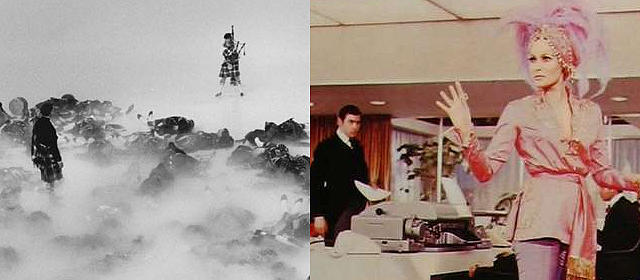
Peter Sellers changed the scene where he and
Ursula Andress are riding an elephant and made it into a dream sequence with 104
kilted Highlanders. The Elephant Boy costume can be seen worn by Ursula in
the spy control room.
Unfortunately, Peter Sellers had one of his
nightly prophetical dreams where his mother was saying not to do the scene
because it was dangerous. So the circus scene went away and 104 kilted
Highlanders was born. Ursula was so upset that Feldman created another scene
where she could wear the Elephant Boy outfit while prancing around her spy
control room with David Niven. Thus the line from a curious Sir James, "Why
don’t you wear that on the street?" "People might stare," says
Vesper.
An expensive solution, but one must feel sorry
for the elephant owner when he arrived with his five-toed pachyderm at the
Shepperton Studio gates, only to be told from a disgruntled security guard that
he was at the wrong studio.
Director Robert Parrish replaced McGrath and was
perplexed when he was greeted with a huge, bare, white, cylindrical set.
"There was nothing in the script to indicate what it was for. I didn’t
know what to do with it and for a few days I just hoped it would go away. But
then Peter came up with his dream sequence and those damn pipers." (New
York Times interview May 22, 1966)
One of those pipers was actor Peter O’Toole.
Feldman paid him a case of champagne for his brief cameo role.
Director Val Guest said in a Scarlet Street
interview, "I went on under contract for eight weeks, and I was still under
contract nine months later. Feldman was a madman. There were days when you could
hug him, and then other days when you could throttle him!"
Guest was in charge of directing the scenes with
Woody Allen as the evil Dr. Noah. Allen was quoted as saying he would have to
leave in the middle of a sentence if this film went on much longer. He had been
in London for months waiting and doing nothing except writing a Broadway play (Don’t
Drink the Water), a screenplay (Take the Money and Run), and winning
at poker. By the time he actually started work he was on overtime.
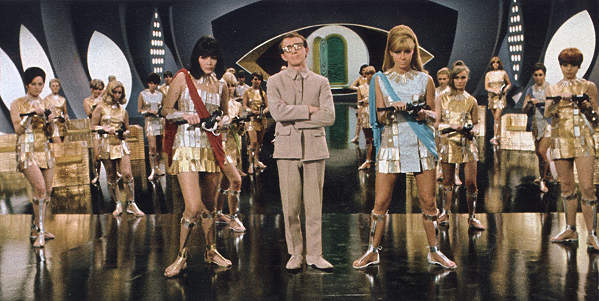
Woody Allen as Dr. Noah with his Guard
Girls.
"My part has been steadily changed, even up
to two days ago," Allen explained in the November 15, 1966 LOOK magazine.
"No matter what anybody brought in to be read at story conferences, their
material was generally received all the way from enthusiastic to wildly
enthusiastic. Then this stuff was never heard from again, in any form whatever."
Allen, who wrote most of his scenes, claimed he had a theory that there was an
unseen house writer chained in Feldman’s dungeon. Allen demanded a signed
confession from Feldman that he, Woody, did none of the writing, although he
tried.
"Think of the old pyramid builders,"
said Allen, "and you have some idea of what Charlie Feldman is like, lavish
in the Egyptian tradition of lavish."
Director Ken Hughes, who directed the Cubby
Broccoli film The Trials of Oscar Wilde, was the last director hired.
When he showed up on his first day he was surprised to see that the Art
Department had built a $30,000 replica of the Taj Mahal. "I just wanted a
simple backdrop to suggest a temple where Joanna Pettet does her shimmy with all
these swinging monks," he said. "Instead, they went and built this
behind my back. I won’t use it. Take good care of old Ken, Feldman said."
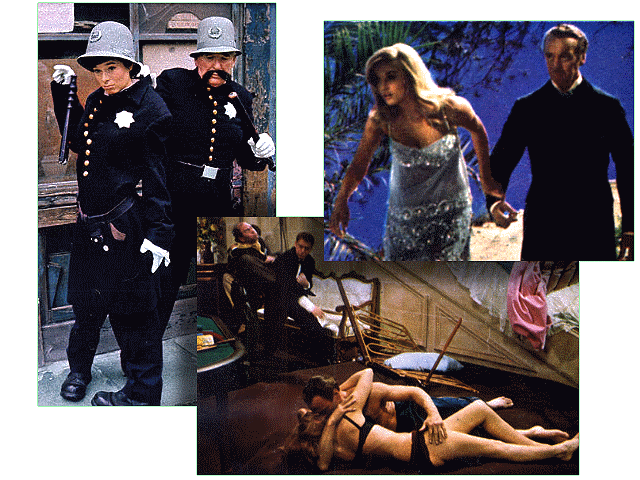
Top Left: Geraldine Chaplin (Charlie's
daughter) and Richard Talmadge can be seen as the Keystone Cops. Top Right:
Moneypenny and Sir James sneak around Dr. Noah's island hideout from this
deleted scene. Bottom: Another deleted scene finds two lovers
embraced during the final battle scene in Casino Royale (Photos courtesy
Playboy).
Legendary stuntman and director Richard Talmadge,
was in charge of the second unit. His contribution to the film is the final
chaotic battle scene inside Casino Royale. "Let’s blow up the whole
picture," Talmadge said to LOOK magazine. Dubbed Custer’s Last Stand it
included U.S. Calvary and American Indians colliding with Smersh’s croupiers
in a scene that looked as if it had been lifted from an old silent Keystone Cop
film. The entire scene took six weeks to film and featured 200 actors and extras.
Insurance firm, Lloyds of London, was so worried
about this scene that they suspended the insurance during this portion of the
film. The main reason was due to Talmadge, who had directed the train wreak
scene in How the West Was Won, when one of the stuntmen was crushed under
fallen timber. Feldman was gambling on Talmadge’s professionalism and said,
"If he had lost, some widows might have owned his picture.
With all the mayhem, Feldman’s health began to
wane. He suffered a heart attack during the production, which he blamed on
Sellers. "I’d be in my grave if I ever started anything like this again.
Everyday a new crises with people who have reached a certain point, good or bad,
in their careers. Stars are no real insurance for the success of a picture, you
know, except possible for the performance they give. In my grave. . ."
Royale Pain
Columbia Pictures announced that Casino Royale
would open no sooner than Christmas 1966. This would give United Artists’
next Bond entry You Only Live Twice some breathing room with six months
between pictures and no competition from a first run film. This probably gave
some solace to producer Cubby Broccoli, who faced competition in another form
after releasing his Oscar Wilde film in 1960 one week after Gregory Ratoff’s
version. Any form of a competing Bond film would spell disaster at the box
office. However, Columbia’s commitment came and went and the release date was
pushed to mid April 1967.
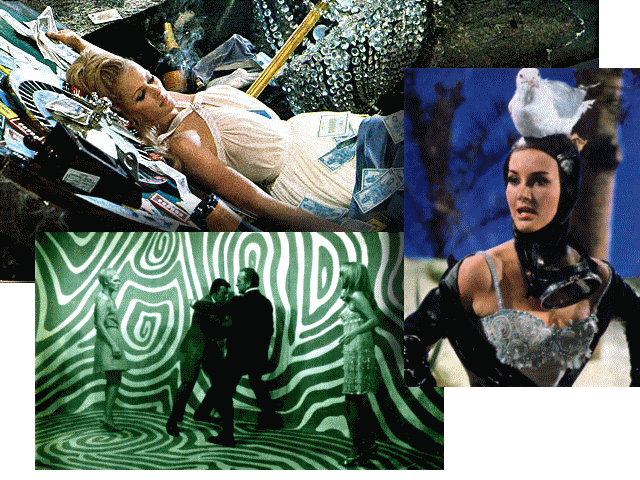
Three more deleted scenes - Top: Vesper is
found dead on top of the roulette table. Right: Moneypenny evades Dr.
Noah's guards by disguising herself in a wetsuit and fake duck (homage to
Goldfinger's pre-credit segment). Bottom: Mata Bond, Cooper, Sir James,
and Moneypenny try to break out of Dr. Noah's psychedelic maze.
By early January, John Huston walked away from
the film with scenes still not filmed. He told a surprised Val Guest that
he would be shooting his remaining scenes. Guest was now left alone to
finish the monstrosity. For his dedicated commitment, Feldman offered an
additional credit in the form of Coordinating Director. Guest barked,
"This is coordinated? If you do that, I’ll sue you!" A compromise
was reached and Guest received ‘Additional Sequences By’ which is the last
part of the opening credits.
Heavy publicity followed in the months leading up
to the premiere. Columbia Pictures promotional department flooded countless
magazines with articles such as the Playboy spread called ‘The Girls of Casino
Royale’ with commentary by Woody Allen. Movie theaters hung huge posters
depicting the actors and a nude, tattooed covered lady. Audio clips would play
over their lobby speakers announcing the arrival of the film with the tag line -
"Casino Royale Is Too Much For One James Bond" .
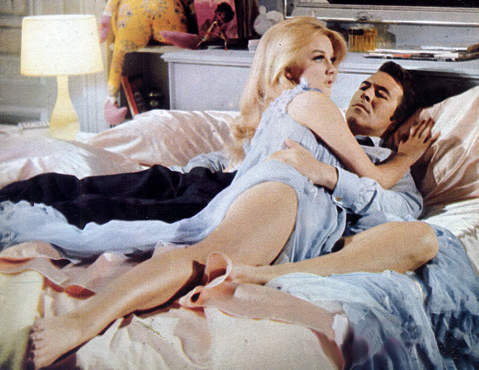
Terrence Cooper and Barbara Bouchet work
overtime to save the free world.
The war of the Bond movies had reached a pinnacle
when United Artists began to advertise You Only Live Twice with bold
lettering saying "Sean Connery IS James Bond". Three campaign posters
would be made depicting Sean Connery being bathed by geisha girls, flying his
‘Little Nellie’ helicopter while fighting off SPECTRE’s flying army, and
the interior of Blofeld’s volcano hideout during the final battle scene with
Connery hanging upside down from the crater opening. With all the exposure
between these two films, James Bond was becoming ‘too much for the average
moviegoer’.
With all the negative morale during the
production, Feldman was convinced he had a sure winner and proceeded to prove to
the world that his film was the ultimate crowd pleaser.
In New York City, Feldman gave a press party on
the roof of Broadway’s Screen Building. He unveiled a 62' x 100' sign of the
classic tattooed lady and served Hebrew National hot dogs and champagne. Also in
attendance was 60's pop icon Twiggy, shown viewing the trailer to Casino
Royale.
The Cannes Film Festival was hoping to get in on
the fun by having Casino Royale as the show opener. Unfortunately,
Feldman was unable to complete the film in time for the festival.
Legend has it that the film almost did not make
it to its April 13, 1967 premiere at the London Odeon Leicester Square theater.
Apparently a final cut was being prepared inside the projection room. The U.S.
premiere would not happen until Friday, April 28th.
However, a week later on Saturday night, May 6,
1967 in Boston, Massachusetts, a riot broke out outside the Sack Savoy Movie
Theater. According to the report, several thousand persons were denied admission
to a 4am screening of Casino Royale. Radio station WRKO had promised free
admission with doughnuts and coffee or soft drinks to any ‘spy’ who showed
up wearing a trench coat. The theater manager, John P. Sullivan, decided to run
the movie two hours earlier because the crowd, mainly youths, had grown to an
estimated 15,000.
Before order was restored three hours later, some
30 persons had been injured, several stores looted and cars smashed. Fifteen
persons were arrested on charges ranging from drunkenness to unlawful assembly.
As policemen converged on the mob outside, the
capacity crowd inside the theater also became unruly. The theater’s assistant
manager, Frank Dubrawsky, said he kept the film running despite two fires in the
seats and a broken fire hose that soaked portions of the audience.
"I was scared stiff to shut the projector
down. They were fighting in the aisles every time someone left his seat,"
Dubrawsky said.
Allen Friedberg, General Manager of Sack
Theaters, said, "Under no condition will there be another preview of this
type by any Sack Theater. I never dreamed that this situation would have
resulted."
Despite being a confusing spoof of the Bond films
and a psychedelic run-up of the 1960s, Feldman’s Casino Royale went on
to gross $17.2 million dollars at the U.S. box office. Eon’s You Only Live
Twice would better that by $2 million more. To this date, debate
continues whether Feldman's film actually did damage to future Bond films.
There is no doubt that the 60s spy craze was fading and underground films such
as Easy Rider and Billy Jack were becoming popular. Bond
films such as 1973's Live and Let Die were still attracting audiences,
but not as good compared to Goldfinger or Thunderball a decade
earlier. For it would not be until 1979's Moonraker when Bond would
break new U.S. box office records.
Perhaps the most redeeming part of Feldman's Casino
Royale is the music score by Burt Bacharach. With lyrics by Hal David
and the title song performed by Herb Alpert & The
Tijuana Brass, the soundtrack became a cult favorite and a highly sought after
collectible among audiophiles. By the late 1980s the LP record could fetch
up to several hundred dollars. The reason behind this was the way the
recording studio processed the record. By increasing the volume to near
over-modulation, the sound gave most stereo sound systems a run-for-its-money.
When the soundtrack was reproduced for the CD generation, the sound from the
original 1/4" tapes was faithfully restored.
On May 25, 1968, Charles K. Feldman died of
cancer. He was 63. His prophetic remark, "I’d be in my grave if I ever
started anything like this again.", reverberated off the obituary of
the New York Times. Two years later Casino Royale would premiere on
CBS television on September 18, 1970. Unfortunately it would not be a rating
blockbuster the network was hoping. The film would eventually fall into
syndicated broadcast oblivion for the next two decades.
To Bond fans worldwide the 1967 version was a
confusing mess. However, in 2000 the Director of Film Studies at the
University of Colorado, Robert von Dassanowsky, wrote a very compelling article
on the
artistic values of Casino Royale.
Gone, But Not Forgotten
For years after 1967, the film rights to Casino
Royale hanged in limbo.
On June 29, 1979, at the New York Museum of
Modern Art, producer Cubby Broccoli, director Lewis Gilbert and film critic
Judith Crist, answered questions from audience members during a panel discussion
on Moonraker and the OO7 films. One question was asked about the
fate of Casino Royale and whether Eon owned the rights. "No, we
don’t own it." said Broccoli. "When the first deal was made
with the Fleming estate to make Bond films, that was already sold." (Bondage
magazine #9)
Ten years later during a visit to a James Bond
film class, the same question would be asked to Cubby’s stepson and
co-producer, Michael G. Wilson.
"United Artist bought out Charlie
Feldman’s rights and Columbia owns the rights in common, so they’re in a
Mexican standoff." Wilson continued, "I think it's an
interesting (Fleming) story - whether it's in our style, the right way to go
with Bond, I don't know? It's a very heavy story in a way. To fall
in love with a woman who is a double agent and be completely misled after all
Bond has been through with her is tough. Then have her commit suicide and
have Bond feel good about it - that's kind of a heavy film." (Bondage
magazine #17)
Wilson shared the forum with Bond fan and future
writer of the official novels, Raymond Benson. In 1985, Benson proposed to
Glidrose (the literary owners of James Bond) that he would write a James Bond
stage play based on Casino Royale.
"I wrote the play in 2-3 months and then
held a staged reading of it in New York City in February 1986, using
professional actors." said Benson during an online interview with John Cox
of CommanderBond.net.
"The reading went very well and we then had a discussion with the audience
about what worked and what didn’t. It’s a shame that Glidrose couldn’t
attend that reading because the outcome might have been different. Anyway,
Glidrose paid me and then they submitted the play to a British theatrical agent.
She was very elderly and in my opinion she just didn’t get it. She recommended
that the play not be produced. After further thought, Glidrose shelved it with
the ultimate decision that a James Bond stage play simply wouldn’t work. The
films had Bond in a monopoly and there was no way a play could compete. I
disagreed, but it was their property."
In early 1997, Thunderball producer Kevin
McClory and Sony/Columbia Pictures teamed up to begin work on Warhead 2000,
a James Bond film based loosely on a treatment McClory worked on with Ian
Fleming in the late 1950s. Sony/Columbia was looking for a franchise movie
series and McClory was the stepping stone they needed in perhaps the most
outrageous lawsuit in the annals of Hollywood history.
In short, McClory/Sony/Columbia sued MGM/UA and
Eon Productions on the grounds that McClory’s story elements from Thunderball
had been exploited in every James Bond film since 1962's Dr. No. A claim
that could yield McClory and Sony millions, if not billions, and the control of
the cinematic rights to James Bond.
The suit was considered ‘dirty pool’ in
Hollywood. The thought of undermining the series away from the Broccoli
family, who has made it successful for over 35 years, was pathetic in the minds
of fans all over the world. By late 1999, Sony/Columbia still had no
competing Bond film. Faced with a negative ruling from a Los Angeles judge, Sony
decided to drop the suit and settle out of court which in turn gave MGM the
distribution rights of Casino Royale. Two years earlier MGM also
won the distribution rights to McClory's Never Say Never Again from
TaliaFilms. Now Eon Productions had control of all the Bond theatrical
titles.
And the First Shall Be Last
In 2004, MGM/UA was sold to Sony/Columbia
Pictures. Their entire library of the best loved musicals, comedies and dramas
would now be controlled by the rival studio. The fate of the James Bond
franchise was in question and delayed the start of Bond 21 until 2006.
However, on February 3, 2005, after the dust had settled between Sony/Columbia
and MGM/UA, Eon Productions made the announcement that the next James Bond film
would be Casino Royale. Fans could not have been happier except that
there was no mention if Pierce Brosnan, the current actor to play OO7, would
return. Other actors such as Dougray Scott, Hugh Jackman, Heath Ledger, Clive
Owen and Eric Bana were potential contenders for the role but on October 14,
2005, the world was in for a bigger surprise than expected.
Arriving in a military speed boat, actor Daniel
Craig (click
here for video), the sixth official actor to play OO7, made his grand
entrance in front of the world press. Craig would later reveal that he was
not interested in the part but was persuaded by producer Barbara Broccoli to
reconsider. "I will not accept the part unless I see the script."
Craig said. After several months and a
revised script by Paul Haggis, Craig was more than satisfied.
According to Premiere magazine (November 2006
issue), while in Baltimore, Maryland working on his latest film with Nicole
Kidman called The Invasion, Craig was picking up laundry detergent in the
Whole Foods Market aisle when his cell phone rang. On the other end, and
literally on the other side of the Atlantic, was Barbara Broccoli. "It's
over to you, Kiddo!," were the words and with that Craig dropped the
detergent and headed to the local liquor store for a bottle of Vodka and
Vermouth. He obviously did not need to shake it, he already was himself.
He gave his mother a call to tell her the news
and to keep it quiet until after the press conference. Unfortunately, one
tabloid reporter called his mother and said, "The news has broken.
What do you think about your son becoming the new OO7?" His mother
nonetheless let the cat out of the bag. A cheap trick that anyone would
have fallen for it.
Unfortunately, the Royale curse continued
and now had Craig in its grasp. "He’s too blonde, too ugly." said
some Internet outlets. "He's not tall
enough. He looks more like a villain than a hero." said other press
sources.
On the website Absolutely
James Bond one disgruntled fan said: "My god, don't the producers
have any brains? Craig is not Bond material. Bond must be tall, dark and
handsome. Or at least two of the three, and he isn't even one!"
Perhaps the biggest news was not Daniel Craig but
the website danielcraigisnotbond. A site endorsed by approximately 50 disappointed fans who feel that Pierce
Brosnan is the only actor who can play Bond. This immediately attracted the
attention of the press and before the cameras began rolling, Craig was the most
unwelcome Bond actor since the early days of George Lazenby.
Negative rumors continued to flood the Internet
on a day-to-day basis. Anything from Daniel Craig being unable to drive a
car with a clutch, to having his front teeth knocked out during a staged fight
scene. Both stories are untrue. Craig, being raised in England, obviously
can drive a clutch and the teeth incident was merely a capped tooth that had
come unglued. The headlines obviously disturbed Craig, but the results
were more positive. He approached the role more serious and more determine
than any other role he had played. He worked closely with the script and
suggested that a scene with a suicide bomber be dropped because the people who
do that for real are divided on religious and political grounds. "If
you are going to show someone setting up a bomb to kill people," Craig said
to Premiere magazine, "Then have him walking away with a case of money
afterwards." Craig even had input into the music and title song.
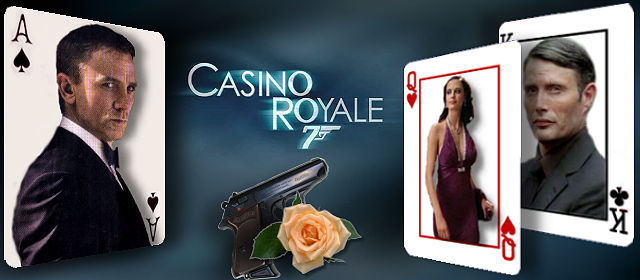
Daniel Craig becomes the sixth actor to play
OO7. Eva Green as Vesper Lynd and Mads Mikkelsen as Le Chiffre.
As the months rolled on however, photos and news
clips would leak onto the Internet showing a very buff and muscular Daniel
Craig, who would spend three hours a night working out in the gym. The rest of
the cast would slowly be announced with Danish actor Mads Mikkelsen playing a
thin Le Chiffre, Eva Green playing the Bond girl who breaks our secret agent’s
heart - Vesper Lynd, and Jeffery Wright playing a black Felix Leiter (previously
played by white actors). By late-summer the majority of fans and non-fans were
beginning to warm up to Daniel Craig as OO7 as the official trailer made its way
onto the Internet. The trailer began in gritty black and white as a young Bond
earns his OO agent status. The rest of the trailer is in color and sets up the
story in modern times as Le Chiffre is the big investment banker for the world's
terrorists. Bond, with the aid of Vesper, must defeat Le Chiffre in a
winner-take-all poker game at Casino Royale. By the end of the trailer, the
majority of Bond fans world-wide were completely satisfied.
Still some fans however have voiced their
concerns about the grittiness of the film and whether it will be too much
compared to the rest of the series. Mads Mikkelson said to Premiere
magazine, "We're talking grittiness compared to the other Bond films.
That's what we're talking, of course we're not talking gritty gritty. That would
be a no-go. The task is to bring this magical universe — it's still a fairy
tale, he's still Superman, I'm still the baddie — into 2006. That's the kind
of grittiness we're talking about."
Unfortunately when one gambles long enough lady
luck is sure to turn, on July 30, 2006, Pinewood Studios largest stage, The
Albert R. Broccoli OO7 Stage, burned to the ground. Inside the stage was the remains of a Venetian
set. Fortunately the crew had finished filming and production staff were
in the process of dismantling the set. This is the second time this stage
burned down. The first time was in 1984 during production of Legend.
Fortunately, no one was hurt in either accident. The OO7 Stage is well
known among Bond fans for housing the submarine set in 1977's The Spy Who
Loved Me.
By late September, the main title song by Chris
Cornell, "You Know My Name" leaked onto the Internet. The
song was met with mediocre results since it lacked a Bondian tune. However,
by mid-October a newer version showed up at Cornell's website with full
orchestration. The results were better than the initial release and set
the tone for the November 17th premiere.
Co-Producer Barbara Broccoli sums up the main
reason why Eon finally filmed Casino Royale, "It was always an
ambition of theirs (Cubby and Harry Saltzman) to be able to make this story but,
sadly, they were never able to. So, when it finally became available to us,
we leapt at the chance. I like to think that I'm doing this for my Dad."
Ironically Ian Fleming’s first novel will be
his last officially adapted for the screen by Eon Productions (all of his
OO7 books have been used either by title or by story). Royale is the
closest to any of his Bond novels since 1969's On Her Majesty’s Secret
Service. However, this film is more about how James Bond became the agent we
all know and love than simply about his relationship with Bond-girl Vesper Lynd.
On the other hand, the 1967 Feldman version is the opposite. It depicts an aging
Sir James Bond, forced out of retirement to fight his greatest nemesis - his
nephew. Only to be blown up with the rest of the world in the final moments of
the climatic battle.
The good news in all of this is that where
Feldman’s version ended with no where to go, Eon’s version will obviously
begin a new chapter in James Bond’s cinematic life. This will no doubt
reverberate from the silver screen at the end of Casino Royale when the
words 'James Bond Will Return'.
Cars in Casino Royale 1967
Casino Royale (Charles K. Feldman's Casino Royale [James
Bond]), Movie, 1967


![]()




![]()
![]()
![]()
![]()
![]()
![]()
![]()
![]()


![]() Open during September 2017 to May 2018 Monday-Friday 11-15. Saturday 10-14.
Other times appointment.
Open during September 2017 to May 2018 Monday-Friday 11-15. Saturday 10-14.
Other times appointment. 





























